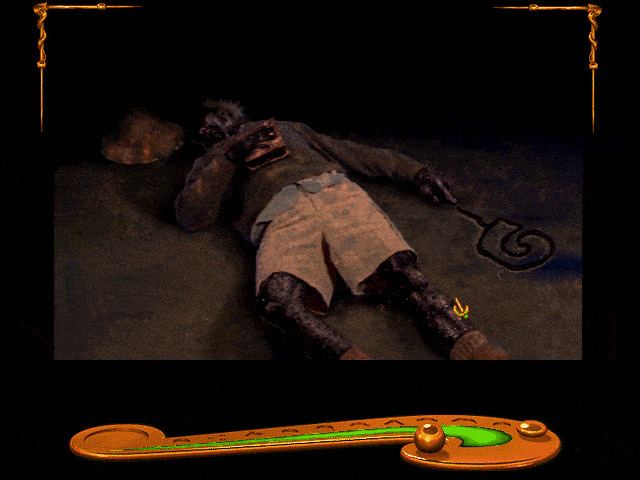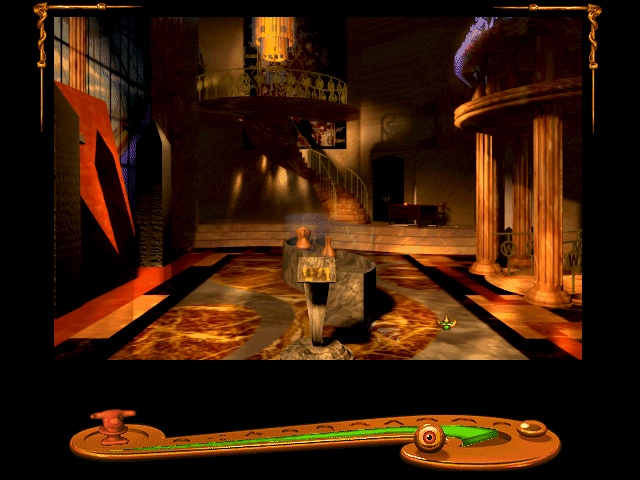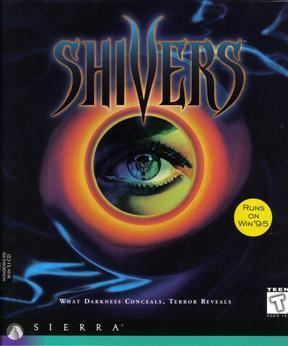9 /10 1 Votes9
Initial release date 1995 Developer Sierra Entertainment | 4.5/5 My Abandonware Mode(s) Single player Designer Marcia Bales Genre Adventure game | |||||||||||||||||||||||||||||||||
 | ||||||||||||||||||||||||||||||||||
Publishers Sierra Entertainment, Dice Multi Media Europe BV Similar Shivers II: Harvest of Souls, Lighthouse: The Dark Being, Rama, Torin's Passage, Pepper's Adventures in Time | ||||||||||||||||||||||||||||||||||
Shivers is a single-player horror-themed PC adventure game, released on CD-ROM by Sierra On-Line on September 30, 1995. It was developed with Sierra's Creative Interpreter. Being the first Sierra 1st-person adventure game, Shivers was compared to contemporary Myst and The 7th Guest, gaining praise mostly for its atmosphere. The game takes place in a fictitious haunted museum.
Contents

Plot

Sir Hubert Windlenot was a peer of the British nobility, and as an archeologist, a member of the Royal Society. His interest in controversial fringe topics such as ancient astronauts, hollow earth, Atlantis and cryptozoology brought on him the reputation of a mad scientist. Denouncing his life as a noble, he moved to America, and attempted to open "Professor Windlenot's Museum of the Strange and Unusual" in Mt. Pleasant, Ohio, dedicated to his findings and theories. Construction took two decades to house both exhibits and thematic installations with several puzzles to entertain the visitors (such as an Ancient Egyptian-themed artificial lake, an underground maze that leads to a Dero installation, a greenhouse, or a diorama dedicated to Atlantis). The museum was never completed until the Professor mysteriously disappeared.

The player steps into the shoes of a teenager dared by his friends to spend the night on the grounds of the museum, that has been considered haunted.
Upon entering and exploring the museum, it is discovered that "fifteen years ago", in 1980 and while the Professor was in one of his excursions, two nerds from the local high school had broken into the museum and accidentally released evil spirits from an exhibited set of ceramic vessels from the Moche Valley. These spirits, known as "ixupi", drew the "life essence" or "Ka" from humans until trapped by a fictional South American indigenous people, the Zapana. Furthermore, the Ixupi are associated with chemical elements and materials, such as sand, metal, wood or electricity, which they can inhabit. These led to the demise of the unfortunate teens, and eventually of the Professor himself.
The player becomes tasked with finding a way to capture the ten spirits before the sun rises (though no actual time limit is imposed on the gameplay), and free the trapped ghosts of the Professor and the teens. This can be done by finding each vessel and its corresponding talisman/cover throughout all the museum, and where the respective Ixupi is hiding in order to trap it. In order to find all these items, the player has to explore the whole museum by passing puzzles of varying difficulty, mazes and secret passages. Along the way, the player can find in-game texts and documents chronicling the exploits of the Professor and the belongings of the two students expanding their backstory, with elements hinting at their lives, relationships and motivations.
At the end of the game the player captures the Ixupi of electricity from the power generator, causing an explosion. From the destroyed ruins, the player sees the friends approaching, looking for their friend, as the dawn breaks.
Gameplay
Playing in first-person perspective, the game is remarkably similar in style to the Virgin Interactive/Trilobyte production, the popular The 7th Guest, which introduced this style of gaming.
The only gameplay feature is an elaborate bar at the bottom of the screen which mostly serves as a health bar, showing how much "life essence" the player has or has lost; life is lost whenever the player encounters an Ixupi. It also serves as the game's inventory with the active Ixupi vessel or cover the player is currently holding, with the option to examine it in close-up. It also indicates progress in the game, as the vessels with the trapped Ixupi are placed there as trophies.
The vessels and their covers are the only items that can be picked up and stored in the inventory. Uncommonly for an adventure game, the inventory can hold only one of these items: a vessel, a cover, or a vessel combined with its cover. This means that the player can pick up a vessel and then find and pick up its corresponding cover to complete it; but if the player attempts to pick up an item that can't be combined with the one held (i.e. another vessel or a cover corresponding to another vessel), the items will switch positions. This feature obliges the player to take notes of where he has found or dropped which item, and to travel back and forth in order to pick them up.
Having a completed vessel the player can look for the corresponding Ixupi in order to trap it. Each vessel is marked with a Zapana pictograph representing a material, helping the player associate a vessel with an Ixupi.
The locations where the items are found are mostly fixed every time, although which is where is mostly random, ensuring a different gameplay each time the game starts.
A "Flashback" feature allows the player to review game cutscenes and re-read most of the in-game text that has been found, such as books from the museum library or the victims's notebooks. These not only advance the game's backstory but also contain hints to several of the puzzles.
In a somewhat of a deviation from other FMV-based games of the era, dialogues are provided with closed captions. This was a suggestion by Lead Game Developer Willie Eide who came from a deaf family.
Upon completion of the game's main story, the player may then continue to roam freely through the museum, with all captured Ixupis appearing along the health bar. One benefit of this is the luxury of getting to read over the many in game exhibit descriptions without the worry of being attacked by Ixupi. Reading these descriptions or exploring previously undiscovered parts of the museum can continue to add to the player's score.
Development
The game was programmed in SCI-32, the proprietary game engine/programming language by Sierra. A challenge faced by the team was the steep learning curves, as many were inexperienced in 3d modeling or adventure game design, and it was the first time the SCI language was used for a 1st-person adventure video game.
Roberta Williams served as Creative Consultant, which was during the time she was working on Phantasmagoria.
Themes
Designer Marcia Bales credited her interest in travels and archeology as her main drive force for the game. Some of the footage seen in a cutscene were taken by Bales herself during a trip in Belize around 1994.
Regarding the themes seen in the fictional museum, Bales claimed that most of them presented are factual, although stretched out in the way the Professor-based his pseudoscientific theories. The way the museum was designed, with each room assigned to a different artist, reflected the Professor's deductive fallacies of connecting otherwise unconnected facts to draw his conclusions. The elements were left for the player to decide how much of the Professor's theories were arbitrary.
The concept of the Ixupi was a retelling of an almost universal motif of vampiric spirits sucking the life out of humans, often coming out of the elements. The Ancient Egyptian concept of the soul was also an inspiration.
Gameplay
Shivers was the first 1st person adventure game by Sierra On-Line that featured a nameless and unseen silent protagonist, instead of a visible player character.
Bales mentioned the game Mixed-Up Mother Goose Deluxe as an inspiration to design Shivers as an open-ended game, with the random elements enhancing the non-linear gameplay; a characteristic considered uncommon for an adventure game. Once entering the museum, the player is immediately free to explore and access almost all locations, without having to solve a puzzle to see what is next. The player's order of actions are the factor of how the backstory elements are revealed, without mattering the order these are discovered.
Graphics
The game was created using scans of watercolors - some 2500 of them - touched up in Photoshop, along with 3D Studio. Each room was assigned to one out of a team of ten artists with the Art Director ensuring continuity and consistency.
The cutscenes were filmed with live actors in front of a blue screen, who were superimposed on the digital backgrounds with Ultimatte. Each filming would require proper camera angles and lensing before shooting to ensure matching quality with the digital background. Occasionally masonite props would stand for foreground objects. The actors were found by talent agencies and were coached by Bales, producer Wendy Albee and director Tony Ober.
Sound and music
Guy Whitmore worked as a sound engineer, sound designer and music composer for the video game soundtrack. According to context, some pieces where composed as orchestral music whereas others were more modern. Some bands were cited as inspiration, such as Nine Inch Nails. Whitmore also had Dark Ambient music in mind. The interactive nature of the game demanded for a repetitive motif which would provide the background and foreboding mood of suspension for the player, while being unnoticed in the same time. The crescendo happens in the cues whenever the player triggers an attack of an Ixupi monster.
Sound effects were derived mostly from a stock sound effects CD. The mumblings heard in the abandoned theatre is a relevant speech by the Ghost from a Hamlet performance.
Reception
Shivers drew mostly praise for its atmosphere. Presenting a deviation from earlier Sierra titles, the game was both praised and criticized for the same reasons, while it also drew comparisons with Myst and The 7th Guest. It holds an aggregated 72.2% score on GameRankings, based on reviews from various professional critics.
Quandary gave the game a 5 out of 5, praising the atmosphere and simplicity of gameplay, mentioning the ample number of save game slots and closed captions among the game's advantages. French site Jeuxvideo.com gave Shivers a 85% and called it "an undeniable success". In a retrospective review, Adventure Lantern noted that the game still looked fairly pleasant after its time, and its (mostly) clever design, while praising the game's mood and atmospheric soundtrack. Adventure Classic Gaming, giving the game a 60%, named Shivers a sleeper hit of the year and recognised its cult status.
GameSpot gave the game 66% while criticizing the repetitive gameplay as the player was forced to travel back and forth many times after a certain point. Just Adventure also favored the game's atmosphere, and praised the "Flashback" feature, giving the game a 50%.
All Game Guide and Finnish Pelit gave the game a 40%. The former described it as "lacking" while the latter considered it an example of Sierra's downward spiral, criticizing the puzzles and the storyline.
Sequel
Shivers was followed in 1997 by Shivers II: Harvest of Souls which takes place in a ghost town.
